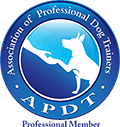Archive CF :: Inhibiting Common Behavior Problems*
There is no greater reminder of the differences between dog and human than in the behaviors that so annoy us and yet are so innate to them. Barking, jumping on us and on our things, tearing apart the garbage -- how exasperating! Here are some techniques to alleviate these nuisances:
Jumping Up
Dogs are very aware of personal space. Jumping up, while usually an attempt to greet face-to-face, is a rude behavior and an invasion of your space. Though a small puppy jumping up to seek your attention might seem harmless enough, the behavior won't seem so trifling when the puppy has grown into a 140-pound Great Dane. And few others will appreciate being accosted by your rambunctious adolescent.
When your pup jumps up on you, cross your arms across your chest and turn away from her. In this way, you are withholding the very thing she seeks: your attention. When she drops back to the floor, you can turn around and reward her polite behavior with pets and love. Remember: Don't use your hands to push her off of you; this is in itself a form of attention from you and will inadvertently reward the behavior.
Should you decide that having your pup jump on you is something you enjoy, you might decide to put the behavior on cue, so that patting your hands to your thighs or chest is an invitation to jump up. Without invitation, though, the behavior should not be allowed.
Demand Barking
It is in our nature to respond and comfort the cries of our babies, whether they be of the human or canine persuasion. Of course, cries of true distress should not be ignored, but demand behaviors are a different matter. Yips of protest when your dog is first left alone in the crate, or an attention-seeking pup shoving her head under your hand any time she wants petting, should not get the desired result, or you will be beleaguered by these behaviors for life. Instead, ask your dog for a polite sit (the doggie equivalent of "please") before petting her. Approach her crate only when she's calm and quiet. If your puppy barks at you for attention or for food, turn your back to her, or put her food away and leave the kitchen. In so doing, you're teaching her that these behaviors impede progress rather than hasten it.
Recreational Barking
Recreational barking is often misdiagnosed as separation anxiety because it frequently happens when the family is absent. Separation anxiety-related barking usually happens immediately upon being left alone and is accompanied by other indicative symptoms, such as destructive (or self-destructive) behavior, breaking of housetraining in a housetrained dog, or anorexic behavior. When barking is the sole symptom, first investigate the possibility that it's recreational.
The act of barking is self-reinforcing so it is a behavior that is likely to intensify without modification. Increase exercise, particularly before leaving for long periods of time, so that your dog is tired and ready for a rest in your absence. Hire a dog walker to break up the time that he is left alone. Incorporate fun mental challenges like stuffed puzzle toys for your pup to work on in solitude. Leave some classical music playing: It can be relaxing and it can also dampen outside noises that might provoke your dog to bark.
As a last resort, the use of a citronella bark collar can inhibit the behavior by establishing an unpleasant consequence.
Counter-Surfing and Garbage Raiding
The problem with these two annoying behaviors is that they are self-reinforcing -- the more times your dog is successful at counter-surfing or garbage raiding, the more difficult it will be to break the habit. First and foremost, when you are absent, make sure your dog has no opportunity to practice the behavior by ensuring that his access to counters and garbage cans is thwarted.
Your best bet is to catch the behavior immediately upon its first occurrence. My dog Trista has only counter-surfed once. On that occasion, I made the mistake of leaving a piece of delicious raspberry cheesecake (made by the Nuns of New Skete, no less!) on a low living room table when I left the room. When I returned, all that remained was a clean plate and a creamy cheese mustache around her mouth, which itself was fast disappearing! And it was too late to correct her -- there had been several seconds between the misdeed and my return. So I fetched another piece of cheesecake, put the plate exactly as I had the first, and left the room, lurking just behind the door jamb. At the very moment that she made her attempt, I yelled "No!" That was her first and last uninvited helping.
Trista's a soft dog, and so this was a good technique for her. It won't work for every dog; many dogs would be more motivated by the cheesecake than deterred by a rebuke. For these dogs, booby traps like sticky tape (sticky side up) or a can of pennies might work. Be careful with fearful dogs, though. A frightening event might have a greater impact than just thwarting counter-surfing -- it could cause fear of the kitchen, for instance. Use prudent, sensitive judgment.
Territorial Behavior
While there are many breeds that show a degree of territorial aggression, we play a huge part in intensifying such behavior, primarily by a lack of supervision. Leaving your dog with access to windows looking onto the street, or unattended in the yard, will allow her to practice territorial behavior unfettered.
A common example is a dog who barks at the approach of the mailman. The mailman's pattern is to approach the house, deposit the mail, and leave. A dog who alarm barks at the mailman and then sees the mailman depart interprets this as her having accomplished her goal of fending off the stranger. Passers-by behave in the same way, nearing the house, then passing it. The sentry dog has been successful again, in her eyes. Rehearsed repeatedly, this pattern can develop into aggression, especially toward those visitors who actually seek entry, as the dog may decide that greater measures must be taken to repel them.
The same behavior can result from a dog with unsupervised access to a fenced-in yard. Dogs and people passing by will elicit aggressive displays that, with daily practice, will become entrenched behaviors.
The best solution is to be an ever-present leader to your dog. Remain nearby as much as possible, ready to shape and reinforce her polite behaviors and inhibit her unpleasant ones. The persistence and consistency with which you supervise your dog will depend on breed characteristics as well as her own unique personality.
* Parts of this article are excerpted from Laura Garber's recently published book, Bringing Up Puppy.




